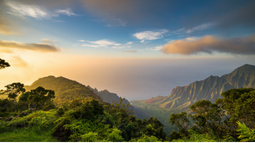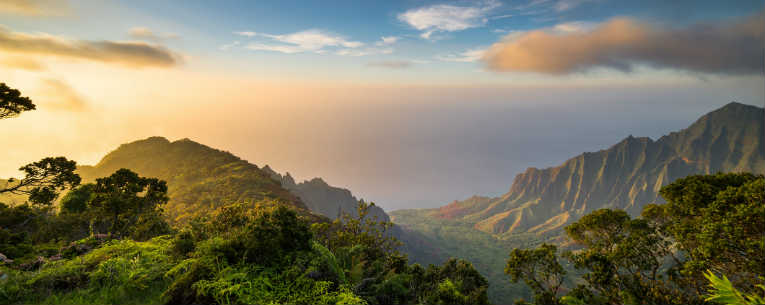When it comes to enjoying Hawaii on a budget, your best bet is to follow the locals.
Sure, you need to get there first, which can be among the biggest costs of visiting the Aloha State, but once you arrive, you’re not a tourist. You’re a shrewd local who knows where to eat, where to shop, what to visit, and even where to lay your head at the end of each day (Pro Tip: It’s probably not a 5-star resort if you’re being thrifty).
The second overarching bit of advice we have for those seeking to experience paradise on a tight budget is be disciplined in plotting your itinerary. You can’t see everything on every island — and do it on the cheap. You can always come back. After all, “Aloha” means hello and good bye.
So let’s take a deep dive into how to visit Hawaii on a budget, looking at how to get there, where to stay, where to eat — and most importantly — what to do.
When to Visit and How to Get to Hawaii On a Budget
We have some great news when it comes to getting to Hawaii on a budget: It’s always beautiful. Yes, it rains a good amount, but then it gets beautiful again.
Similar to other destinations where the sun is shining and the temperatures hang out in the 70s and 80s all year, it’s most crowded when it’s chilly back in the mainland. For that reason, there are two times to consider if you’re looking for more value and fewer crowds: Spring (around Easter break through mid-June) — with the exception of the last week in April when there is a huge influx of Japanese tourists — as well as September through mid-December (with the exception of Thanksgiving and island-specific Aloha festivals).1
When it comes to booking, the earlier the better. And similar to many in-demand destinations, aim for mid-week arrivals and departures when fewer people are flying, and thus, rates are lower.
Here is more good news. There was never a better time to fly to Hawaii than right now: Roundtrip flights from the mainland to Hawaii have even dipped below $300 in some cases, which was previously unheard of. Why? Because there are more airlines, more routes and more aircraft than ever jetting back and forth from mainland hubs to Hawaii’s airports. That translates to more options and more competitive rates, including limited time promotional rates you need to book sooner than later.
Among the new airlines offering service to Hawaii is Southwest, and it’s been proven time and again that when the Texas-based airline arrives in a new market, competitors drop their rates to be more competitive. It’s called the “Southwest Effect.”2 For travelers, it’s a win-win, as it affects our budgets in a very positive way.
How to Get Around & Where to Go in Hawaii on a Budget
Now let’s chat about your itinerary, namely, which Hawaiian islands to visit. While there are more than 130 Hawaiian island spread over 1,600 miles, there are six you should know and consider for your getaway.3 These include (in order of size): the Island of Hawaii (or “The Big Island”), known for Kona coffee and volcanos; Maui, the surfer’s paradise; Oahu, the most populated island and home to Honolulu; Kauai, the “Garden Isle,” Molokai and Lanai.4
Trying to tackle all of these islands isn’t the most cost-effective strategy. Even hopping across a few can add up when you take into account airfare, other transportation costs, and the sheer time spent zig-zagging around. To truly explore Hawaii on a budget, consider immersing yourself in one island, maybe two.
If you’re going to bide your time in one spot, you’re going to want a car to get around and explore. Rental cars can get pricey in Hawaii, so your best bet is to schedule activities so that you only need a rental vehicle for part of the trip, taking advantage of any available public transportation, biking or walking the other time. If you’re going to be at the beach all day, you don’t need a car, right? Take note that if you’re staying on O’ahu, you have access can ride TheBus as much as you’d like over four days for just $35.5
Also, depending on where you’re staying, your lodging may offer a courtesy shuttle to local points of interest. Finally, ride-hail apps such as Lyft and Uber are also popular in Hawaii, and with a recent price cap placed on the services’ surge pricing by the state government, they’re poised to be more affordable than ever.6
So now you have a plan for when you’re coming to Hawaii, how you’re getting there, and how you’ll get around. But what about where you’ll crash after a long day under the Hawaiian sun? You have your pick of resorts, hotels, B&Bs, condo rentals and even hostels. Yes, Hawaii has hostels, and they’re known to be pretty nice, even offering private rooms and included meals.7 Don’t forget airbnb, too, with more than 500 homes listed.
Lodging is a real balancing act because the more you spend, the more you get. And the less you spend, the more you need to purchase a la carte, from meals to transportation and entertainment. But one surefire way to save is to avoid staying right on the beach. You’re going to be a quick walk to the ocean no matter where you stay; there’s no need to be a pineapple’s throw away from it when you sleep. Instead, make sure you secure a room with a refrigerator and kitchenette so you can prep your own meals, which you can find for $100 or less a night on most islands if you look carefully. Yes, that brings us to food…
How To Eat and Drink in Hawaii on a Budget
Make no mistake… Hawaii is out there in the middle of the Pacific Ocean. And its prices, especially when it comes to food and drink, are up there because of its lonely location. But if you eat like a local, you can take a bite out of this big slice of your trip budget.
First off, as is the case with most crowded destinations, avoid the spots the other tourists flock to. Find a fish shack off the beaten path. Or better yet, find a Foodland (remember what we said about making your lodging includes everything you need to make a home-cooked meal?). Not only will shopping for groceries at this chain store and preparing your own meals bring down your food costs, but there is another perk, too. Locals like to grab a poke bowl while they’re out shopping at Foodland. This quick, easy and cheap lunch consists of cubed, raw fish served over rice with dressing and shoyu sauce, and is a reliable source of protein and sustenance for a big day of sightseeing, hiking or even just bumming around the beach while contemplating life’s grand mysteries.8
To further immerse yourself in local life, do your shopping at one of the numerous Hawaiian farmers markets. With up to 90% of goods being shipped to Hawaii from the mainland, this is the spot to find food grown in locals' fields and back yards. If you’re on Kauai, look for Koloa Fish Market. And on Maui, be sure to swing by KCC Saturday Farmer’s Market, the biggest in Honolulu.5
What To Do in Hawaii On a Budget
Now we get to the fun part. And the cheap part. That’s right, exploring Hawaii on a budget is probably the most cost-effective part of your trip. Chalk it up to bountiful natural treasures that are free or nearly free.
For starters, Hawaii boasts eight national parks drawing more than 6 million annual visitors. These range from the Big Island’s Ala Kahkai, a 175-mile National Historic Trail tracing through ancient Hawaiian settlements, to Maui’s Haleakalā, featuring volcanic terrain, a sub-tropical rain forest and refuge for endangered species. Hiking Ala Kahkai is free to the public, and Haleakalā charges $12 per person or $25 per vehicle for a three-day admission. There is also a National Monument, the World War II Valor in the Pacific. This somber and reflective tribute, which includes the USS Arizona Memorial, tells the stories of all the victims and survivors of the attack on Pearl Harbor.9 (You can also visit the Pearl Harbor Memorial in Oahu, as well. Tickets are only $1.50, but because there are only 1,300 available each day, it’s recommended that you reserve yours in advance, up to two months before your trip.8
If you’re looking for a little pick-me-up, check out the Big Island’s manifold coffee farms, which take advantage of the area’s unique volcanic soil to grow world-famous Kona beans. You’ll find more than 650 coffee farms dotted around the slopes of Muana Loa and Hualalai, many of which offer free tours and coffee samples. So skip your morning joe and grab a mug of the really good stuff (and maybe some to bring home, too). Some of the farms to check out include Sunshower Farms, Hula Daddy and Mountain Thunder Coffee Plantation. (We’ve got a whole article dedicated to Hawaii’s rich Kona coffee history and proud tradition if you’re thirsty for more.)10
There is always surfing, too. Hawaii has more than 1,600 recognized surfing sites. And if you need that first surfing lesson, book some time with the top-ranked Maui Surfer Girls.11
If you opt for a hotel or resort, odds are you’ll have some built-in entertainment, too, from luaus to tours. Check out these options you might have already “paid for” before shelling out to a third party.
Here are two more quick tips to save a buck here and there: You know those coupon books you normally toss out or recycle? In Hawaii, these offer some legit discounts and offers, so be sure to thumb through free magazines and coupons handed out by street hawkers; you might just find that sweet starwatching tour for less. And if you’re celebrating a special occasion, from a honeymoon to a birthday, let folks know about it. You might just get a slice of pineapple upside down cake or a round of Mai Tais on the house
With a little planning, a willingness to eat like a local and wee bit of discipline, exploring Hawaii on a budget is 'A'ole pilikia (“no problem”). Just remember; you can always come back.
Related Articles








Share this Page